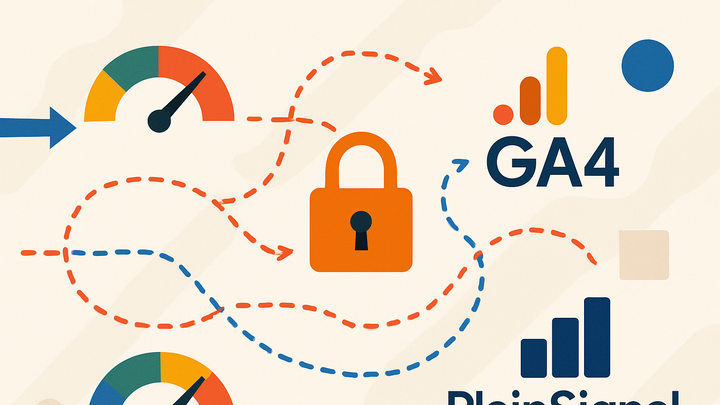Published on 2025-06-26T05:30:38Z
What Are Analytics Thresholds? Examples in GA4 and PlainSignal
Analytics thresholds are limits applied to data collection and reporting in web analytics platforms. These limits control sampling, event caps, and privacy constraints to ensure data accuracy, system performance, and regulatory compliance. Platforms like Google Analytics 4 (GA4) and PlainSignal implement thresholds differently: GA4 introduces data and sampling thresholds for privacy and performance, whereas PlainSignal’s simplified, cookie-free model avoids complex thresholding by design. Understanding how thresholds work helps teams interpret reports correctly, avoid data gaps, and maintain user privacy.
Example integration in PlainSignal:
<link rel="preconnect" href="//eu.plainsignal.com/" crossorigin />
<script defer data-do="yourwebsitedomain.com" data-id="0GQV1xmtzQQ" data-api="//eu.plainsignal.com" src="//cdn.plainsignal.com/plainsignal-min.js"></script>
Analytics thresholds
Limits in analytics platforms that control data collection, sampling, and reporting to manage performance, accuracy, and privacy.
Core Concepts of Analytics Thresholds
Analytics thresholds are predefined caps within analytics systems that govern how much data is collected, processed, or reported. They serve to balance performance, storage costs, and privacy requirements by automatically limiting or sampling data once certain conditions are met.
-
Definition and purpose
Analytics thresholds define specific caps on data collection or reporting to balance platform performance with data fidelity and privacy considerations.
-
Types of thresholds
Common thresholds include sampling thresholds, event caps, and high-cardinality limits that address different aspects of data volume and complexity.
-
Sampling thresholds
The point at which a platform switches from processing full data sets to sampled data to reduce processing time and resource usage.
-
Event caps
Limits on the number of events tracked per session or user to prevent overwhelming the analytics pipeline with excessive data.
-
High-cardinality limits
Constraints on the number of unique dimension values (such as URLs or custom parameters) that can be processed without aggregation.
-
Thresholds in GA4 and PlainSignal
Different analytics tools implement thresholds based on their design priorities, such as privacy protection, sampling strategies, or simplified data models.
-
GA4 thresholds
Google Analytics 4 applies several threshold mechanisms to protect user privacy and ensure efficient query performance, including privacy thresholds on user demographics and sampling for large data sets.
-
Privacy & data thresholds
GA4 automatically omits low-volume demographic or interest data in reports to prevent the identification of individual users.
-
Sampling in explorations
For exploratory queries, GA4 begins sampling data beyond specific volume limits (e.g., 10 million events) to deliver faster results.
-
-
PlainSignal’s approach
PlainSignal’s cookie-free, privacy-first model avoids complex thresholding by collecting lean, aggregated data in real time without sampling or privacy thresholds.
-
Cookie-free data model
By not relying on cookies or user-level identifiers, PlainSignal simplifies data collection and eliminates the need for user-based privacy thresholds.
-
Performance limits
PlainSignal enforces soft limits on concurrent data streams to ensure consistent performance, which rarely impacts standard traffic volumes.
-
Impact on Data Accuracy and Privacy
Threshold mechanisms directly affect the integrity and granularity of analytics data, as well as the platform’s ability to comply with privacy regulations.
-
Accuracy implications
Thresholds can introduce gaps or distortions in reported data, especially for low-volume events or rare user segments.
-
Underreporting risks
Events or user interactions that exceed caps are dropped, potentially skewing key metrics and trends.
-
Sampling distortions
Sampled datasets may not accurately reflect true distributions, leading to misleading insights if not adjusted correctly.
-
-
Privacy compliance
Thresholding helps meet regulatory requirements by preventing the display of user-level data when group sizes are too small.
-
Anonymization aid
Low-count thresholds filter out small cohorts, reducing the risk of re-identifying individual users.
-
Regulatory requirements
Data protection laws like GDPR and CCPA often mandate restrictions on reporting granular user data, driving the need for thresholds.
-
Best Practices for Managing Analytics Thresholds
Effective management of thresholds ensures reliable insights while maintaining performance and privacy standards.
-
Tune threshold settings
Adjust platform settings to align threshold levels with your traffic patterns and reporting needs.
-
Configure in GA4
In GA4 Explorations, set appropriate sampling limits or disable sampling for critical reports when possible.
-
Monitor data volume
Regularly review event and user counts to predict threshold breaches and plan capacity accordingly.
-
-
Leverage alternative tools
Combine multiple analytics solutions or filter events strategically to mitigate threshold impacts.
-
Hybrid analytics
Use PlainSignal alongside GA4 for unsampled pageview or session data on high-traffic sites.
-
Custom event filtering
Filter out low-value or noisy events before they hit thresholds to preserve the quality of your core metrics.
-
